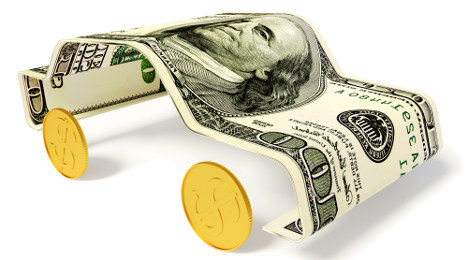DriveTime Automotive Group ownership is eliminating its subprime auto finance company that originated paper with franchised and independent dealerships for the past five years. GO Financial president Colin Bachinsky said the company stopped accepting applications from dealerships late on Wednesday.
During an exclusive phone conversation with SubPrime Auto Finance News, Bachinsky emphasized why DriveTime owners chose to wind down GO Financial, which launched back in 2011. Bachinsky explained the reasoning behind ownership's decision in light of GO Financial pushing out a pair of securitizations last year.
“This is not a performance-based decision at all,” Bachinsky said. “There’s obviously been some negative news tied into the ABS market over the last six months. This is not at all in our belief regarding the stability or the overall sentiment of the ABS market. It has nothing to do with that. It’s all to do with the uses of resources and capital.”
GO Financial currently has about 65,000 accounts in its portfolio, which the company still will continue to collect payments from those consumers until terms are expired “to maximize the return on that asset that we’ve built,” according to Bachinsky.
“We’re happy to see that those loans are continuing to perform and those pools are continuing to perform better than expected and better than what the ratings agencies placed those expectations,” Bachinsky said. “Our securitizations are performing better than expected, and we have not seen any deterioration in our portfolio. We would expect that positive continuing.”
Bachinsky explained that GO Financial soon would finalize the underwriting process stemming from the dealership applications it accepted through Wednesday. By May 27, he expects that the company would have all of its originations completed.
“If we have some straggling documentation requests over the next several months, we’ll be working through those with our dealers. We have a project plan pulled together to mitigate our risk there,” Bachinsky said.
Bachinsky told SubPrime Auto Finance News that DriveTime leadership discussed what to do with GO Financial for the past several months and reached a decision last week. GO Financial’s 530 employees were notified on Monday.
Bachinsky indicated that GO Financial will retain about 250 workers who will manage the current outstanding portfolio, oversee collections and handle other chores associated with customer service. The company plans to have its account holders continue to make payments as they have been while keeping its online payment portal open as well.
“Nothing changes for those people. They will continue to pay GO just like normal,” Bachinsky said.
What eventually will change are the positions for GO Financial’s workforce. Bachinsky highlighted that more than 90 percent of that group is destined for posts within DriveTime’s portfolio of companies. That collection includes:
— Carvana, an online vehicle retailer with a growing network of distribution locations in states such as Florida and Texas.
—SilverRock Holdings, which provides F&I products such as extended vehicle service contracts, global positioning system (GPS) theft recovery products, guaranteed asset protection products (GAP) and auto insurance solutions to consumers through independent and franchised dealers as well as the newly rebranded.
—Bridgecrest Acceptance, which launched earlier this year as a licensed third-party servicer for servicing installment contracts for DriveTime and other affiliated finance companies.
“It’s definitely difficult, being a part of GO since the very beginning,” Bachinsky said. “From that perspective, it’s difficult, but I recognize it’s a business decision. It’s just a continuous evolution of our overall model and family of companies.
“The good news is we’re a part of this larger group of growing companies,” he continued. “All of those companies are continuing to grow. Our owners are looking at it from the standpoint of looking at the different businesses that are growing and what resources are available; just trying to reallocate those resources both in the form of capital as well as people back toward these other businesses.”
While also touching on how the subprime auto finance company is navigating challenges in both collections and rolling out securitizations, Consumer Portfolio Services highlighted that it closed the first quarter by originating the most contracts ever in a single month.
During Q1 of 2016 that closed on March 31, CPS purchased $312.3 million of new contracts compared to $269.2 million during the fourth quarter of last year and $233.9 million during the year-ago quarter. During the company’s quarterly conference call, chairman and chief executive officer Charles “Brad” Bradley Jr. wasn’t sure whether it was solely tax refund monies that pushed CPS to originate a record amount of paper in March, which happened to coincide with the 25th anniversary of the company.
“It’s really hard to figure out, and to be honest, I don’t know that we really care,” Bradley said.
“What we care is we’ve got a nice little kick in the first quarter, which we didn’t have in the previous two years,” he continued. “That enable us to have a strong originations. We actually got back to our 2007 levels. March was a record month in terms of originations in one month.”
The Q1 origination amount left the company's managed receivables total at $2.142 billion as of March 31 an increase from $2.031 billion as of Dec. 31 and $1.726 billion when the first quarter of last year finished.
All of the first-quarter origination activity coupled with its rising portfolio helped CPS to generate earnings of $7.2 million, or $0.24 per diluted share. The figures were down a bit year-over-year as net income in the first quarter of 2015 came in at $8.3 million, or $0.26 per diluted share.
CPS did generate a 17.1-percent increase in revenues as the Q1 figure was $100.6 million, up by $14.7 million above the year-ago amount of $86.0 million.
Cutting into the company’s net income was a 24.1-percent jump in total operating expenses as the Q1 figures climbed from $71.2 million to $88.4 million.
Looking at the financial statement from the perspective of pretax income, CPS sustained a 17.1-percent decrease year-over-year as the metric fell from $14.7 million to $12.2 million
Despite the income declines, Bradley defended CPS’ performance during his opening remarks to investment analysts.
“We’re still quite profitable, making lots of money,” he said. “We’re making more money than we ever made before and so we’re really doing pretty well at that.
“And so as much as we’re not personally all that happy with CPS’ performance on its own, if you hold this up to the rest industry, we look surprisingly great,” Bradley went on to say.
Looking at collections
CPS reported that its annualized net charge-offs for the first quarter came in at 7.57 percent of the average owned portfolio as compared to 6.64 percent a year earlier.
The company also mentioned delinquencies greater than 30 days (including repossession inventory) stood at 8.97 percent of the total owned portfolio as of March 31 as compared to 6.86 percent when Q1 of 2015 closed.
When discussing these topics, Bradley acknowledged that “collections remain a challenge.” He insisted that both the regulatory environment finance companies navigate nowadays as well as how consumers communicate are changing significantly as they would rather trade text messages than phone calls.
“We used to call people at home and the phone on the wall would ring,” Bradley said. “Today it is the phone in their pocket and they’re not always wanting to answer that phone. So you have to come up with new ways to do things.”
A look at securitizations
After the first quarter closed, Consumer Portfolio Services announced the closing of its second term securitization of the year, a $332.7 million deal. The April transaction was CPS’ 20th senior subordinate securitization since the beginning of 2011 and the third consecutive securitization to receive a triple-A rating on the senior class of notes from two rating agencies.
Even though the transaction didn’t happen during the reporting period CPS shared, Bradley still assessed how the auto ABS market is impacting the company’s performance.
“The price and cost of funds has gone up significantly over the last few quarters. It certainly different world than a year ago in terms of what it cost to get securitization done,” Bradley said.
Having said that the cost of funds still low when we look at our historical average in terms of what it cost to get deals done,” he continued. “There’s still lots of appetite, but the people in the market mostly want to get paid a little more. And so that’s sort of an interesting new dynamic in that market that might be somewhat challenging as we go forward, so we will see.”
Fitch Ratings not only is looking at how subprime auto ABS is behaving; the firm also investigated and projected how the dealer floor plan ABS sector should perform.
Analysts think dealer floor plan ABS will remain stable despite Fitch’s expectation of an approaching new-vehicle sales plateau following historic growth observed during the past five years.
“However, U.S. dealership groups remain in strong financial health, contributing to stable expected performance metrics for the DFP ABS sector,” Fitch said.
The firm explained that solid dealer financials, built on strong revenue and decreasing costs, have led to positive migration to stronger credit tiers within DFP trusts. Fitch noticed dealer defaults have been minimal and net losses for most trusts remain at or near zero.
Monthly payment rates (MPRs), as measured by Fitch's Auto DFP MPR Index, averaged 41.3 percent for 2015 collection periods, marginally below the previous peak of 41.7 percent in 2013, but well above any other year for the index, which dates back to 2004.
“We expect MPRs and other performance metrics to normalize in 2016 as production and incentive levels continue to increase for nearly every auto manufacturer, as off-lease vehicle supply due back at dealer lots is expected to reach high levels,” analysts said.
Fitch acknowledged that it has observed the negative effect of these two factors on MPRs for certain trusts. But the firm expects MPRs to remain above early amortization triggers.
“Other performance metrics are also expected to remain solid. Fitch believes dealers are better positioned today to weather the storm any headwinds may bring,” analysts said.
Fitch calculated that average dealer profits rose to $1.17 million in 2015, up 7.4 percent over 2014, driving average return on equity for dealerships to 29.5 percent. This figure is up marginally from 29.2 percent in 2014, but well above all levels observed over the last decade.
“Rising dealership blue sky values have driven M&A activity into high gear, highlighted by Berkshire Hathaway’s recent purchase of the Van Tuyl Group, one of the largest U.S. dealership groups,” Fitch said.
“While new-vehicle sales in the U.S. rapidly increased to historic highs in recent years, the number of dealerships has remained relatively flat,” the firm continued. “Sales increased 5.8 percent year-over-year in 2015, but the number of dealers increased by only 0.3 percent, according to the National Automobile Dealers Association.”
Analysts also pointed out that truck sales have contributed to the improved financial positions for dealers “as consumers are flocking to dealers for new in-demand models in the low fuel price environment.” Fitch determined trucks accounted for 57 percent of new-vehicle sales in 2015, rising from 53 percent in 2014 and well above any level observed since 2000.
“Trucks carry higher retail pricing points and are therefore more profitable for dealers,” analysts said.
Fitch also mentioned another trend that is aiding dealers and their balance sheets.
“Dealers have also benefited from lower costs due to low benchmark rates and heightened lending competition compressing spreads,” analysts said. “The result is low dealer financing costs to floor plan vehicles from the manufacturers, typically one of the largest dealer expenses.
“However, with the recent rate increase in late 2015, floor plan interest expenses have risen slightly,” they continued. “Fitch believes the higher expenses could erode into profits levels in 2016, but not materially.”
Fitch currently rates six outstanding auto DFP trusts with $15.9 billion in notes outstanding from 20 Fitch-rated series. These include notes from Ally Master Owner Trust, BMW Floorplan Master Owner Trust, Ford Credit Floorplan Master Owner Trust A, GMF Floorplan Owner Revolving Trust, Mercedes-Benz Master Owner Trust and Nissan Master Owner Trust Receivables.
Consumer Portfolio Services announced the closing of its second term securitization of the year earlier this week. The transaction is CPS’ 20th senior subordinate securitization since the beginning of 2011 and the third consecutive securitization to receive a triple-A rating on the senior class of notes from two rating agencies.
In the transaction, the finance company indicated qualified institutional buyers purchased $332.7 million of asset-backed notes secured by $340.0 million in automobile receivables purchased by CPS. The sold notes, issued by CPS Auto Receivables Trust 2016-B, consist of five classes.
Ratings of the notes were provided by Standard & Poor’s and DBRS and were based on the structure of the transaction, the historical performance of similar receivables and CPS’s experience as a servicer.
| Note Class |
Amount |
Interest Rate |
Average Life |
Price |
S&P Rating |
DBRS Rating |
| A |
$162.86 million |
2.07% |
.86 years |
99.99659% |
AAA |
AAA |
| B |
$53.72 million |
3.18% |
2.19 years |
99.98786% |
AA- |
AA (high) |
| C |
$56.27 million |
4.22% |
2.96 years |
99.63882% |
A- |
A (low) |
| D |
$35.02 million |
6.58% |
3.73 years |
99.66959% |
BBB- |
BBB (low) |
| E |
$24.82 million |
8.14% |
4.44 years |
98.89697% |
BB- |
BB (low) |
CPS pointed out the weighted average coupon on the notes is approximately 4.65 percent.
The company went on to mention the 2016-B transaction has initial credit enhancement consisting of a cash deposit equal to 1.00 percent of the original receivable pool balance and over-collateralization of 2.15 percent. The final enhancement level requires accelerated payment of principal on the notes to reach overcollateralization of 5.65% of the then-outstanding receivable pool balance.
CPS added the transaction utilizes a pre-funding structure, in which CPS sold approximately $224.3 million of receivables today and plans to sell approximately $115.7 million of additional receivables during May.
“This further sale is intended to provide CPS with long-term financing for receivables purchased primarily in the month of April,” the company said.
“The transaction was a private offering of securities, not registered under the Securities Act of 1933, or any state securities law,” CPS went on to say. “All of such securities having been sold, this announcement of their sale appears as a matter of record only.”
Fitch Ratings insisted that March’s drop in delinquencies connected with U.S. subprime auto ABS — after hitting a 20-year high in February — represents a “reprieve” that is “not likely to last.”
According to in the firm’s latest monthly index results, delinquencies on U.S. subprime auto ABS decreased to 4.15 percent in March reporting from the 20-year high of 5.16 percent analysts spotted in the February data. Fitch then explained why the one-month reduction isn’t likely to continue.
“Driving the decline was borrowers taking advantage of tax returns to pay off debts,” analysts said. “The decline in delinquencies, while still 16.5 percent greater than the same period in 2015, follows seasonal trends observed in Fitch's Auto ABS Indices.
“Performance metrics will improve as 2016 shifts into the spring months, though to what extent remains to be seen,” they went on to say.
Fitch also reported that subprime annualized net losses improved in March, declining to 8.58 percent from 9.74 percent. Despite the positive shifts downward, the firm’s report pointed out that net losses last month still came in 30.4 percent higher over same period a year earlier.
“Pressure from weaker underwriting standards in 2013 to 2015 transactions will continue to negatively affect the indices in 2016 irrespective of seasonal trends,” analysts said.
“Increased lending to borrowers with weak or limited credit history will move delinquency and loss frequency levels higher, while negative shifts in (loan-to-value) and extended term loans will drive loss severity up,” they went on to say.
Fitch reiterated a point mentioned in its previous update — that weaker underwriting is largely coming from newer nonprime lenders who have entered the market since 2010 and now account for a larger portion of the index.
In 2010, Santander Consumer USA and GM Financial (formerly operating as AmeriCredit) accounted for 93.5 percent of the notes issued into the market. Today, Fitch calculated that the two finance companies account for 49.5 percent of the market, highlighting the significant growth of new operations.
“To gain market share, many lenders have weakened underwriting standards in the past few years due to the intense competition in the sector,” Fitch said.
Moving over to the prime sector, Fitch noticed lower delinquencies in March as the reading came in at 0.63 percent. That level was down from 0.69 percent spotted in February. Fitch added that losses in the prime space also fell to 8.58 percent from 9.74 percent.
“Consistent with the subprime sector, delinquencies and losses for the prime sector are higher versus the same period a year earlier, with delinquencies 5 percent higher and losses up notably by 55.6 percent. However, both metrics remain historically low and well below recessionary levels,” Fitch said.
The latest Fitch report also mentioned the Manheim Used Vehicle Index – which has been historically high over the past five years — declined again in March to 122.5 from 123.5 in February.
“The supply of used vehicles on the wholesale market is expected to balloon to historically high levels over the next three years, as a result of the large increase in the volume of off-lease vehicles and higher vehicle trade-in volumes,” Fitch said.
“If used-vehicle values decline, so too will recovery rates on repossessed vehicles, which will only confound issues and drive up loss rates, particularly in the subprime sector,” the firm went on to say.
Fitch’s prime auto loan ABS index currently includes 126 transactions with $62.9 billion in collateral outstanding while the subprime index includes 134 transactions with $38.1 billion outstanding.
“Fitch includes transactions in each index based on both historical platform cumulative net loss levels as well as collateral attributes. Certain platforms which do not fit the criteria for either index due to their unique nature are not included,” analysts said.
The volume of auto-financing discussion — especially in the subprime space — Cox Automotive chief economist Tom Webb entertained at recent industry events and his quarterly conference call prompted him to ask a question.
Recent analyst reports from Fitch Ratings and Moody’s Investors Service highlighted deterioration in performance in the subprime auto ABS market, prompting several of the investment analysts who join Webb’s quarterly call to inquire about whether financing availability, particularly in the subprime space, is about to be reduced.
“The subprime area certainly has gotten a lot of notice as of late. And I’m actually beginning to question myself in that am I missing something? I think the cycle has longer to run simply because for the most part we’re in a low-interest rate environment so there’s a search for yield and auto loans provide that yield with very low risk actually,” said Webb, who hosted the call last week on the heels of being in Las Vegas for conferences orchestrated by the American Financial Services Association and the National Automobile Dealers Association.
“There’s certainly been some reports now of some smaller players in the subprime and new players in the subprime area; players that are doing something that really hasn’t been done before in terms of alternative measures in order to provide credit to people who have absolutely no credit history,” he continued.
“You would expect that there would be a little volatility,” Webb went on to say. “Whether it crops back up into the bigger subprime market, you have to be concerned when you get a lot of reports along those lines. However I do believe it will remain favorable for the used-vehicle environment. It’s extremely important for the used-vehicle environment.”
Some of those smaller finance companies were pinpointed by Moody’s in its report, which Webb acknowledged, “was a little more troubling for me; although these numbers really have not been a secret.” He then explained what can happen when ratings agencies such as Fitch and Moody’s push out a series of negative assessments about what’s happening in the space.
“To a certain extent as the ratings agencies get nervous, they can make their own predictions come true if you start dialing back on availability or changing the amount of enhancement that has to go into the ABS,” Webb said.
“Again, the overall financial market remains relatively flush with liquidity,” he continued. “Generally speaking, most delinquencies have not spiked in term of the overall numbers, and people do make their payments except when they have the shock of a job loss, illness or divorce; those three prime reasons.
“If the underwriting standards weren’t completely off the mark then you would think that the loans would continue to perform well. Again, the problems we’ve seen are from some very small players,” he added.
While the latest assessment about delinquency from the American Bankers Association’s Consumer Credit Delinquency Bulletin doesn’t carve out subprime financing specifically, the organization noticed only a slight uptick in auto finance delinquencies in the fourth quarter.
ABA indicated direct auto loan delinquencies — contracts arranged directly through a bank — rose from 0.74 percent to 0.75 percent. The association added that indirect auto loan delinquencies — financing arranged through a third party such as a dealer — climbed from 1.51 percent to 1.54 percent.
The composite ratio, which tracks delinquencies in eight closed-end installment loan categories, remained at 1.41 percent of all accounts in the fourth quarter, according to the bulletin. ABA pointed out that what fueled the overall reading was home-related delinquencies were down significantly in two out of three categories, with home equity loan and line delinquencies continuing a downward trend and approaching their 15-year averages for the first time since the recession.
“It’s been a long, rocky road, but home equity delinquencies have finally worked their way back to historical norms,” ABA chief economist James Chessen said. “The strong and consistent rise in home prices over the last three years has restored equity, which makes keeping loans current even more of a top priority for homeowners. With rising home equity and shrinking delinquencies becoming the status quo, banks are more willing to extend new home equity loans and lines to qualified borrowers.”
Chessen is anticipating that continued consumer discipline and steady economic conditions will help keep delinquencies near historically low levels for the foreseeable future.
“The national savings rate is at one of its healthiest points since the recession and trending upward, which means people are well-positioned to repay their debts,” Chessen said. “Disciplined saving, along with steady job growth and climbing household wealth, signal that delinquency levels are likely stay near these historic lows for some time.”
But in the auto finance world, a metric to watch might be softening vehicle prices as the Manheim Used Vehicle Value Index is now on a streak of three consecutive months of declines. Should vehicle wholesale prices tumble significantly, Webb recognized that the trend could magnify what’s happening in the auto ABS space.
“We sometimes call it that there is a virtuous circle that can sometimes can turn into a vicious circle,” Webb said. “The virtuous circle is what we have had so far in this recovery where the recovery rates on any repossessions are extremely high, which gives the lenders more confidence to lend and make credit available.
“Of course, each one of those repossessions has to go back out and be re-retailed usually with a subprime loan attached to it. That just keep the cycle going,” he continued.
“Once recovery rates become poor, then the credit availability starts to dial back in and with credit availability dialing back in, your recovery rates fall further,” Webb went on to say. “A significant fall-off in used-vehicle values would hurt those recovery rates. But certainly as they say, the frequency of the loss is much more important than the severity of the loss.
“It can become a self-fulfilling vicious circle,” he added. “I don’t think we’re there yet in terms of wholesale pricing. But if credit availability were to dial back substantially then yes, you’re going to hurt used-vehicle values by that factor.”
Moody’s Investors Service not only spotted the trend but pinpointed seven different finance companies that might be causing the softening performances in U.S. subprime auto asset-backed securities during the past few years.
Analysts indicated in a report released on Thursday that a growing number of transactions from smaller finance companies that cater to weaker-credit borrowers — in combination with looser underwriting — has resulted in higher aggregate net losses.
“Any measurable weakening in pool performance does, however, relate to specific lenders and transactions, and loan pools from the larger subprime lenders continue to perform within the rating agency's expectations,” Moody’s said.
Analysts explained that low losses on loan originations from 2010 and 2011, along with low interest rates that kept the cost of funds down, meant higher profits, which enticed new finance companies into the auto ABS market.
As these finance companies have competed for customers, Moody’s asserted that underwriting in the subprime auto finance market has weakened, though slowly, with “favorable” economic conditions helping to offset any resulting deterioration in overall loan performance.
"Since 2010, issuance of U.S. subprime auto ABS has shifted to include an increasing number of transactions from lenders that cater to borrowers with weaker credit scores,” Moody’s vice president and senior analyst Peter McNally said.
“As a result, a greater proportion of the loans in ABS pools have incurred losses, and the average loss rate for U.S. subprime auto ABS deals has risen,” McNally continued.
Moody’s then went on to mention specific institutions.
The report claimed Global Lending Services, GO Financial and Skopos Financial issued their first transactions during 2015, all with “relatively high” early losses.
Moody's added that other sponsors of transactions with “relatively high” losses also include DriveTime Automotive, American Credit Acceptance, United Auto Credit and CarNow Acceptance.
“The risks from deteriorating transaction performance would hit primarily smaller lenders that have fewer resources to manage rising numbers of problems loans, which would exacerbate performance weaknesses and could even threaten their solvency,” analysts said.
Meanwhile, the report mentioned the vehicle installment contract pools in most Moody’s-rated auto ABS transactions continue to perform within expectations, particularly those from AmeriCredit and Santander Drive, the two largest U.S. sponsors.
But analysts pointed out that the number of contracts from AmeriCredit and Santander Drive has fallen to just over 20 percent of total transactions today, down from more than 70 percent in 2010.
Moody's isn't the only firm to discuss the decline in subprime auto ABS performance. Last month, Fitch Ratings pointed to three reasons why delinquencies on U.S. subprime auto ABS have eclipsed 2009 recessionary levels and are now at a level not seen in nearly two decades.
When Fitch Ratings reported recently that U.S. subprime auto ABS delinquencies ballooned to levels not seen in almost 20 years, the development sparked plenty of industry reaction.
To clarify whether or not this market segment is in a profound tailspin, SubPrime Auto Finance News reached out to Equifax chief economist Amy Crews Cutts, who refuted many of the assertions the report made and offered some perspective on what finance company executives might be seeing next.
At the start of a conversation this past Friday, Cutts stressed that, “What I want to make totally clear here is I’m looking at the total market portfolio of America. Fitch is narrowly looking at ABS securities. They’re different populations and theirs is a subset of ours.
“This is important because the mixture of who is issuing securities, what those investors are looking for, what will the market bear on those securities, can influence the performance of those differently than we might see in the broader market,” she continued. “In particular what I found disturbing with the Fitch report was the concept that this is the highest delinquency rate that we’ve seen.”
Cutts explained that she combed through Equifax’s data, looking through vehicle installment contracts held by commercial banks as well as finance companies, the sector that often underwrites the most subprime paper.
“In the total market view, we’re not seeing this sort of record level of delinquency,” Cutts told SubPrime Auto Finance News. “We’re seeing a small increase in delinquency, but it’s still from very low levels.
“Historically we had much higher delinquency rates in 2009 when the Great Recession really got rolling and lots of people lost their jobs. That had a profound effect on auto-loan performance,” she continued.
Last Monday, Fitch analysts indicated subprime delinquencies of 60 days or more hit 5.16 percent for February reporting, marking the highest level observed since October 1996 (5.96 percent). During the most recent recession, the firm indicated delinquencies peaked at 5.04 percent in January 1999.
Fitch also determined February’s delinquencies represented increasing of 11.63 percent year-over-year and 3.63 percent on sequential basis.
So why are the conclusions so different between Equifax and Fitch?
“Within that narrow context of what Fitch is looking at, I dug a little deeper and I think part of it is are new entrants who came into particularly subprime lending since the Great Recession. Some of these are new issuers and I think they’re going through some growing pains. Those issuers were not in the Fitch index prior,” Cutts said.
Cutts elaborated about why she spent a significant amount of time reviewing Equifax’s data before sharing these asserts with SubPrime Auto Finance News.
“I wanted to be very cautious in this, but I feel there was a tremendous overreaction to what happened in the Fitch report as opposed to the bigger picture,” she said. “Part of the bigger picture is that I do believe that there is an appropriate amount of lending that should happen in the marketplace. The trick is knowing when you are doing it right, given the business cycle, given the technology that’s available.
“My experience has been after something like the Great Recession and any time there is tremendous credit losses, lenders get very, very conservative, too much so. Basically the only people who can get credit are those who don’t need it,” Cutts continued.
“As we’ve come out of this financial crisis, which really caused lenders of all kinds to really rethink their models, we’ve seen tremendous change brought about not only by the investors demanding much more prudent use of their money but also regulators stepping in the court of public opinion which has made subprime a dirty word,” she went on to say.
Cutts also mentioned that she’s not noticing a tremendous erosion in credit quality in the auto space with respect to consumer credit scores. She pointed out this deterioration happened when subprime mortgages grew tremendously 10 years ago.
“I was looking at these and saying I should be able to see this and pinpoint where this is happening and I can’t see it in our data,” Cutts said. “The credit score for the 10th percentile — so 90 percent of credit scores are better than this — and we’re seeing no change at all overall.
“I looked at banks. I looked at finance companies. These guys are doing the same things they’ve been doing for four years,” she continued. “I don’t know why the recent ABS that Fitch pointed out is performing so poorly relative to those that came before because at least on the face of it I’m not seeing in our data.
“With mortgages, there was a tremendous erosion of the quality of those loans as people bet on you can’t lose in real estate. There’s not that speculative piece here with cars,” Cutts went on to say.
SubPrime Auto Finance News then questioned whether this reaction would spook the market and finance companies would find difficulties finding capital to keep underwriting volume moving higher. Cutts replied by stating, “Do you want the rational or the emotional answer?”
First, Cutts gave what she called the rational perspective.
“The rational answer is that just as in any financial market dealing, whether we’re talking about equities or bonds or whatever, there are those that perform very, very well and those that don’t,” she said. “They perform very well meaning meeting expectations.
“The rational response would be to look at those issuers who have issued this ABS that are not performing relative to expectations and to find out what it is about these lenders and those ABS. Then you can figure out as an investor if you want to pursue that or not. Maybe I want to go to different one but I’m still happy with ABS,” she continued.
Then came what Cutts called the emotional response.
“‘Oh wow as a group, which is the Fitch numbers, these things are suddenly looking really bad.’ So the emotional answer is I’m just not going to invest there,” Cutts said. “We see these kinds of emotional moves in the markets, which creates tremendous volatility.”
In the final analysis and considering current data and past precedents, Cutts offered a hopeful forecast — or at least one that might benefit finance companies most.
“My hope is that investors will do the right thing, which is to be very vigilant about who they do their business with and how they place their money and hold these companies accountable for answers to these questions before they’re willing to extend capital,” she said.
“I think it would be a shame certainly for investors to pull out of this market because I think there is a tremendous amount of good lending that’s happening by finance companies that are the primary issuers of these kinds of ABS right now,” Cutts went on to say. “As a blanket statement I think that would be both unfair and losing out on a tremendous opportunity.”
Fitch Ratings pointed to three reasons why delinquencies on U.S. subprime auto ABS have eclipsed 2009 recessionary levels and are now at a level not seen in nearly two decades.
On Monday, analysts indicated subprime delinquencies of 60 days or more hit 5.16 percent for February reporting, marking the highest level observed since October 1996 (5.96 percent). During the most recent recession, delinquencies peaked at 5.04 percent in January 1999.
Fitch determined February’s delinquencies represented increasing of 11.63 percent year-over-year and 3.63 percent on sequential basis.
Analysts also noticed subprime annualized net losses have followed the rise in delinquencies, reaching 9.74 percent as of February, an increase of 34.10 percent year-over-year and 11.59 percent from January reporting. Despite the increase, Fitch noted annualized net losses remain below the recessionary peak of 13.14 percent experienced in February of 2009.
“Sharp origination growth, increased competition and weaker underwriting standards over the past three years have all contributed to the weaker performance of the past year,” Fitch Ratings said.
The firm recapped that subprime ABS issuance averaged a little more than $20 billion in 2013 and 2014 before ballooning to more than $25 billion a year ago, marking the highest level since 2005 and 2006.
Fitch also mentioned the number of finance companies issuing ABS also increased to 19 last year compared to the previous high of 14 in 2005 and 2006.
“Increased competition has led to increases in loan-to-value ratios and extended term lending,” analysts said. “Additionally, lenders have marginally weakened credit standards, with particular increases in originations to borrowers with no FICO scores.”
Fitch reiterated that it only rates ABS platforms sponsored by two of the larger finance companies in the subprime sector, General Motors Financial and Santander Consumer USA. Analysts mentioned cumulative net losses on their recent ABS transactions from 2013 to 2015 are rising marginally but remain well within Fitch's initial expectations.
“Enhancement growth has been strong despite slightly weakening performance and, as such, Fitch consistently upgraded subordinate bonds in 2015 and has continued to do so in 2016, thus far,” analysts said.
In contrast, Fitch highlighted performance within the prime sector remains stable, albeit slightly weaker.
Analysts indicated 60-day delinquencies stood at 0.46 percent for February reporting, up 9.27 percent on a sequential basis but flat compared to the same period a year earlier.
Fitch reported that Prime annualized net losses has increased slightly in 2016, reaching 0.69 percent for February representing an increase of 32.17 percent year-over-year.
While representing the highest level since February 2011 (0.90 percent), analysts explained losses are still “well below” the historical average of 0.92 percent and the recessionary peak of 2.23 percent in January 2009.
“Fitch considers the slight increases in losses to be more of a normalization trend within the prime sector as performance trends move away from historical lows experienced over the past five years,” analysts said.
“However, loss levels could rise further if loan-to-value ratios and extended-term lending are not adequately managed and continue to increase,” they continued.
Fitch expects both prime and subprime auto loan ABS asset performance to improve over the spring months with the onset of tax refunds.
“That said, typical seasonal benefits are likely to be more muted this year versus recent years given rising pressures on the aforementioned asset performance as well as anticipated weakness in the wholesale market,” analysts said. “Both the prime and subprime sectors have been buoyed by strong used vehicle values over the past five years, contributing to lower loss severity on defaults.”
With new-vehicle sales and expected off-lease vehicle supply levels at historical highs entering 2016, Fitch anticipates “weakness” in the wholesale market as reflected by the Manheim Used Vehicle Value Index. Manheim recently noticed the index dipped 1.4 percent in February.
“Any future declines in the Manheim Index, as well as other market indicators, will likely contribute to higher loss severity for defaults and drive losses higher,” analysts said.
Despite further weakness anticipated, Fitch continues to have a stable outlook for prime and subprime auto ABS asset and ratings performance in 2016. Analysts pointed out that annualized net losses are expected to rise at or near the 1 percent and 10 percent area for prime and subprime, respectively, “both well within peak recessionary levels.”
Fitch’s indices track the performance of $99.5 billion of outstanding auto loan ABS transactions, of which 61.68 percent is prime and the remaining 38.32 percent is subprime ABS as of February reporting.
Santander Consumer USA highlighted that its auto financing originations moved higher both during the fourth quarter and for the full year. However, the finance company that also serves as the captive for Fiat Chrysler Automobiles acknowledged it lost market share.
And SCUSA believes it knows the places where the market share went.
“If you take the top 20 lenders in the market as a group, the top 20 lenders lost share in the fourth quarter, and if you look at them all individually, there are only a few that didn’t lose share,” SCUSA chief executive officer Jason Kulas said when the company shared its Q4 and 2015 financial report.
“We obviously lost some share in the fourth quarter. But, if you compare that to the smallest players in the industry, the smallest players actually picked up share,” Kulas continued. “So, there’s this interesting dynamic going on where the people with the most history and the most data have held the line on credit and structure and lost a little bit of share, and the smaller competitors at sort of the very low end from a size perspective in the industry, appear to be picking up some share.”
Kulas was quick to calm any fears investment observers might have had about SCUSA’s origination capabilities and its market status. The company wrapped up Q4 with $5.9 billion in originations (up 7 percent year-over-year) and generated $27.9 billion in all of 2015; a figure that landed 6 percent higher.
“That’s not a trend because it’s only happened over the last quarter or so, as far as the smaller players, but it’s something we want to watch because the move was pretty significant relative to where they were entering the quarter,” Kulas said.
“Just a sign, I think again of some of the increase in competition,” he added, “So that leads us obviously to watch things very closely.”
The impact of smaller finance companies taking a bigger piece of the market pie also spilled over into SCUSA discussing its performance in the ABS market.
“What we’ve seen is there’s still a lot of demand, and so you’re right, many different types of issuers have been able to access the markets fairly successfully,” Kulas said when asked about the topic. “What we’ve seen as far as changes, is that — and I mentioned this last quarter — there’s been a little bit of an increase in the spreads for the executions, but the demand is still there and that continues into early 2016 with the transaction that we priced recently.
“Although we’re seeing it, the market continues to have its challenges, and so I think what you’re seeing reflected in the market right now is concern about where we are in the credit cycle, concern about some of the volatility that they’re seeing in the credit markets,” he continued.
“Our perspective on that is that we have a significant following in the credit markets because we have such a long history of performing through cycles,” Kulas went on to say. “We tend to be in a position, as liquidity goes away, that we remain fairly strong on a relative basis, and so I think we’ll benefit from that.”
Overall performance
SCUSA reported its net income for fourth quarter came in at $68 million, or $0.19 per diluted common share. That’s down compared to third quarter net income of $224 million, or $0.62 per diluted common share, and fourth quarter of last year of $247 million, or $0.69 per diluted common share.
Executives explained the most recent were negatively impacted by lower of cost of market adjustments on the held for sale personal lending portfolio, driven by seasonal balance increases as earnings were positively impacted by provision model adjustments.
The company’s full-year net income rose to $866 million, or $2.41 per diluted common share, up 13 percent from $766 million, or $2.15 per diluted common share in 2014, and up 3 percent from 2014 core net income of $842 million, or $2.37 per diluted common share.
“We continue to be strategic in our originations approach, maintaining disciplined underwriting practices and selectivity while growing auto originations 6 percent over the prior year,” Kulas reiterated.
“Recognizing our reported results for the quarter are challenging, there are several factors that are not a true reflection of the earnings power of our franchise,” he continued.
“I would like to thank our employees, customers and dealers for being a large part of another successful year. SC's fundamentals remain robust and we remain committed to generating shareholder value,” Kulas went on to say.
SCUSA highlighted its finance receivables, loans and leases held for investment increased 4 percent to $30.0 billion as of Dec. 31, up from $28.8 billion a year earlier.
The company indicated its average APR as of the end of the fourth quarter for retail installment contracts held for investment was 16.8 percent, in line with 16.9 percent as of the end of the third quarter and up from 16.0 percent as of the end of Q4 2014.
“The year-over-year APR increase is driven by the opportunity to increase originations in a disciplined manner within lower FICO buckets at appropriate returns,” executive said.
SCUSA noted its provision for credit losses increased to $800 million Q4, up from $560 million a year earlier. Executives mentioned the Q4 2014 reading benefited from $149 million in model impacts, including seasonality and a reduction in months' coverage; neither of which impacted provision in Q4 2015. The year-ago figure also benefited from $58 million due to outperformance in net charge-offs.
“Additionally, effective in the fourth quarter 2015, SC recognized changes in value of the personal lending portfolio, including customer defaults, as lower of cost of market adjustments in net investment gains or losses, rather than recognizing provisions and charge-offs on this portfolio,” executives said.
They went on to point out that after adjusting for these impacts and net growth and mix of the portfolio, Q4 2015 provision was impacted by $41 million related to deterioration of forward-looking loss expectations, consistent with the trends in net charge-off ratio and delinquencies.
SCUSA’s net charge-off ratio and delinquency ratio on the individually acquired retail installment contract portfolio increased to 9.6 percent and 4.4 percent, respectively, for Q4 2015 from 8.1 percent and 4.2 percent, respectively, for the fourth quarter 2014. The company’s full year net charge-off ratio on the individually acquired retail installment contract portfolio was 7.3 percent.
After adjusting for lower of cost of market impairments, the company’s the net charge-off ratio of 7.0 percent was up 10 basis points compared to 2014.
"This quarter, seasonal balance increases and seasonally high customer default activity drove net investment losses on our personal lending portfolio, which was classified as held-for-sale as of the beginning of the quarter,” SCUSA deputy chief financial officer Jennifer Davis said
“Balances on this portfolio and customer defaults both generally decline throughout the first half of the year, so we expect smaller lower of cost of market adjustments over the next couple of quarters,” Davis added.
SCUSA announces approximately $900M in asset sales related to its personal lending business
In other company news, SCUSA said on Monday that it completed the sale of assets from its personal lending portfolio to an undisclosed buyer. The portfolio was comprised solely of Lending Club installment loans with an unpaid principal balance of approximately $900 million as of Dec. 31.
“This sale is consistent with our decision, in the third quarter of 2015, to focus on our core objectives of expanding the reach of our vehicle finance platform, creating opportunities in our serviced for others platform, diversifying our funding sources and growing capital,” Kulas said.
“The assets in the personal lending portfolio were classified as held-for-sale beginning in Q3 2015, and we are pleased that this sale of a significant portion of the portfolio is complete,” he continued.
Deutsche Bank Securities acted as sole financial advisor and Mayer Brown acted as legal counsel for SCUSA.












